
Naturally PowerShell is your friend, simple and efficient.Īs before shared virtual disk files have to be attached to a vSCSI controller in the virtual machines that access it and it needs to be stored on a CSV. … browsing to the vhds, selecting it and applying the settings to the virtual machine. You just add it to all nodes of the guest cluster by selecting a “Shared Drive” to add to a SCSI controller … In both cases both vhds and avhdx are created for you, you do not need to specify this.

Or via PowerShell in the way you’re used to with the only difference being that you specify vhds as the virtual disk extension. You can create on in the GUI where it’s just a new option in the New Virtual Hard Disk Wizard. Whether this virtual disk is fixed or dynamically expanding doesn’t matter. As a matter of fact, you can rename this off line avhdx file to vhdx, mount it and get to the data. This means the virtual disk file can be manipulated by the hypervisor and you shouldn’t really do anything with it. Note that an avhdx is often associated with a differencing disk or checkpoints. The vhds file is used to handle the coordination of actions on the shared disk between the guest cluster nodes? This is the “backing storage file” in Microsoft speak. This is a vhds virtual hard disk file of 260 MB and a fixed or dynamically expanding avhdx which contains the actual data.
#Where is the virtual optical disk file located upgrade
The benefit of this is that you will not be forced to upgrade your Windows Server 2012 R2 guest clusters when you move them to Windows Server 2016 Hyper-V cluster hosts. This way is still available to us in Windows Server 2016. It provides shared storage for use by virtual machines without having to “break through” the virtualization layer. Shared VHDX was first introduced in Windows Server 2012 R2.

Time to take a first look at shared virtual disks in Windows Server 2016 and how they are set up. Introduction to shared virtual disks in Windows Server 2016


 0 kommentar(er)
0 kommentar(er)
